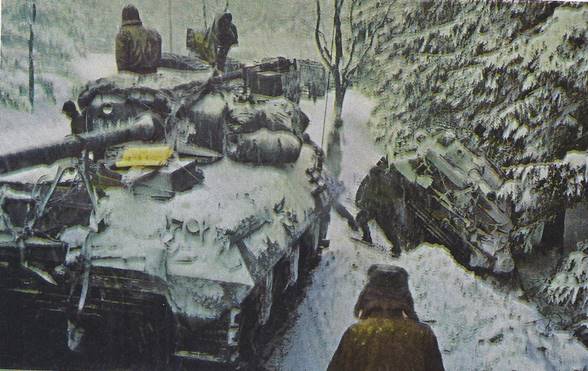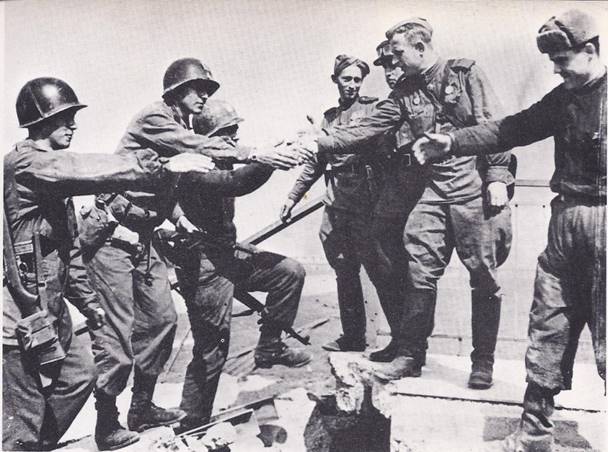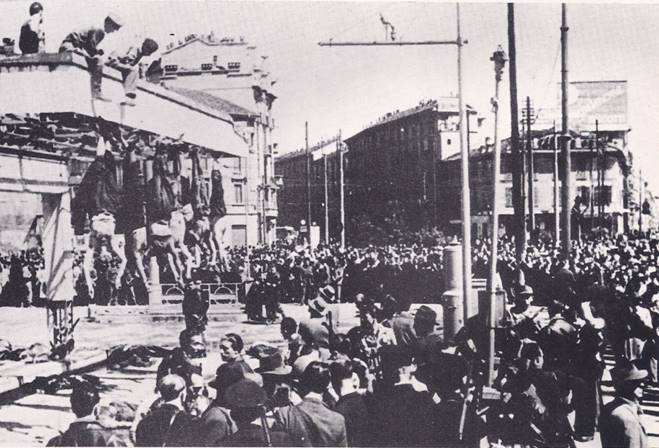Even before Pearl Harbour, there had been cooperation between the United States and Britain. In August of 1941, President Roosevelt and Prime Minister Churchill met secretly, on a cruiser at sea off the coast of Newfoundland. There they drew up the Atlantic Charter, a document stating the principles on which they based their hopes for a better future for the world. They pledged that neither country would seek more territory. They hoped that, “after the final destruction of Nazi tyranny,” all men in all lands could “live out their lives in freedom from want and fear,” and they called on all nations to give up the use of force and disarm.
With the United States in the war, the cooperation among the nations fighting the Axis powers became still closer. There were meetings between the heads of the nations and their representatives — the first of many that would take place throughout the war. Out of the early meetings came an important decision. All possible strength must be thrown against Germany, for once Germany was defeated, Japan would surely fall. On January 1, 1942, all twenty-six nations fighting the Axis signed a pact. Calling themselves the United Nations, they agreed to abide by the Atlantic Charter and not to make a separate peace with the enemy.

As the year began, the Germans started an offensive in Africa. General Rommel and his Afrika Korps won back El Agheila, which the British had taken the previous April. By the end of June, 1942, the British had lost 80,000 men and had been forced to retreat 400 miles to El Alamein, in Egypt. This was only 60 miles from the city of Alexandria and there was danger that Rommel would cut off the Suez Canal.
Rommel could not take El Alamein. The British Eighth Army received reinforcements‚ new equipment from the United States and a new commander, General Sir Bernard Montgomery. In October, Montgomery began pounding at the Germans with artillery and bombing them from the air. The following month, after a hard battle, the British drove the Germans from El Alamein and pushed them across the Egyptian border. Montgomery chased Rommel across the desert into Libya, taking Tobruk, Bardia, Derna and Bengazi. The Germans lost about 75,000 men and in January of 1943 Montgomery entered Tripoli.
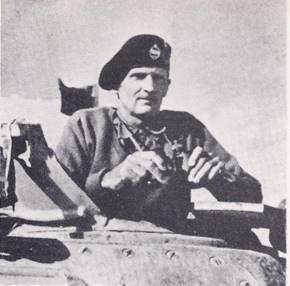
While Montgomery was battling the Germans at El Alamein, the British and Americans were preparing another move — a joint operation against French North Africa, commanded by General Dwight D. Eisenhower. The attack began on November 8, 1942. More than 500 ships, protected by 350 naval vessels, brought thousands of American and British troops to the beaches of Morocco and Algiers. Although General de Gaulle urged the French troops not to resist, there was fighting at Oran and Casablanca. Three days later, Admiral Jean-Francois Darlan, who was the commander of the Vichy French forces, ordered his men to cease fire. Germany’s answer to this was to send troops into the part of France it had not yet occupied. Germany also tried to capture the French naval vessels at Toulon‚ but some escaped, while the others were scuttled by their own crews.
Montgomery’s action in Africa removed the threat to the Suez Canal; the invasion of French North Africa was the largest amphibious operation that had yet taken place in history. Even so the most important event of this period of the war took place on the Russian front.
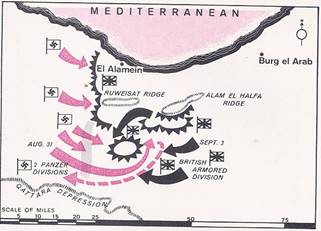
In the spring of 1942, Hitler gathered huge forces for a great offensive “to wipe out the entire defense potential remaining to the Soviets.” In the north, the Germans were to take Leningrad. In the south, they were to break through the Caucasus Mountains to the oil fields. In the southeast, they were to drive across the Don River, split the Russian forces and take the city of Stalingrad. These were Hitler’s plans; carrying them out was another matter. By July, the Nazis had indeed taken Sevastopol in the Crimea, but only after long and hard fighting. They also took Rostov, and reached the port of Novorossisk on the Black Sea, but again the fighting was long and hard, they failed to break through to the oil fields and Leningrad, where the long siege had made the people familiar with starvation, continued to hold out.
The battle for Stalingrad began in August. The city was an important communications and supply center and its loss would have been a serious blow to the Russians. By September it was in ruins, its buildings and factories smashed by artillery shells and bombs dropped from the air. The Russians refused to give up. They fought for every inch of territory, from block to block, from building to building, from room to room. The Germans were losing as many as 2000 men a day and reporting that it was impossible to count the corpses. Against the advice of his generals, Hitler was determined to take the city and in the middle of October he renewed the attack. “I would not have believed such an inferno could open up on earth,” a Russian general said. “Men died but they did not retreat.”
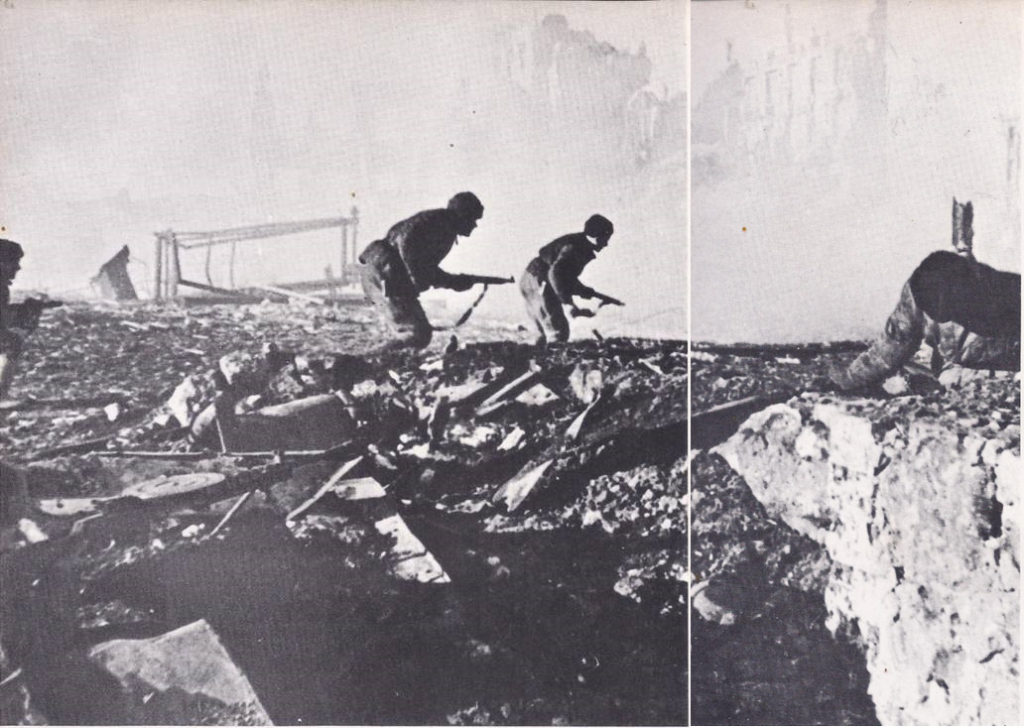
Men died but they did not retreat — that was the story of the Russians at Stalingrad. As October gave way to November, Hitler’s generals warned him again. Again Hitler disregarded them and ordered his men to fight on. On November 19, the Russians began to encircle the Germans from the north and the south. In the bitter cold of winter, the Germans tried to drop supplies by plane. Another German force attacked, trying to relieve the men who were being surrounded, but it was no use.
When the Russians gave the Germans a chance to surrender, Hitler turned it down. “Surrender is forbidden.” he said and the Russians began to close in. Pushed into an area of four by eight miles, bombarded by artillery, bombed from the air, the Germans fought in the streets. At last, as the temperature dropped to twenty-four degrees below zero, 91,000 Germans surrendered, among them twenty-four generals. They were all that remained of an army of 285,000 men.
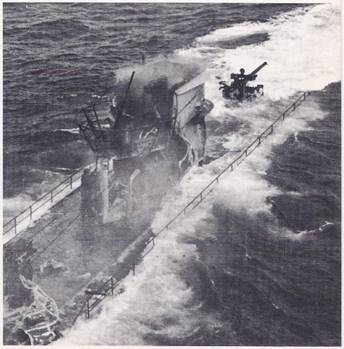
By February 2, 1943, the battle was over. Besides losing so many men, Germany lost more materials than the allied forces had lost at Dunkirk. A German historian said that Stalingrad “was certainly the greatest defeat that a German army had ever undergone,” and it proved to be the turning point of World War II.
In Africa, too, the United Nations forces were successful. The British, now under General Harold Alexander, the commander of the Near East front, pushed forward against Rommel and another German army under General von Arnim. Bizerte and Tunis surrendered on May 7, 1943, and on May 13 General Alexander sent this message to Churchill: “Sir, it is my duty to report that the Tunisian campaign is over. All enemy resistance has ceased. We are master of the North African shares.” Thousands of Germans had died in Africa and almost 250,000 had been taken prisoner.
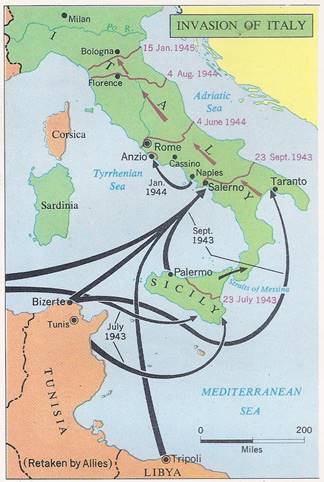
At sea, convoys of ships with men and supplies were getting through in spite of the German submarines, which had sank ships within sight of the American coast. In the air, American and British planes were bombing German cities, destroying factories and military installations, bringing the war home to the German people. On May 30, 1942, the British had bombed the city of Cologne with 1000 planes in the first of their massive air attacks. The war was not yet over, the fighting would still go on, Europe would still suffer death and destruction, but the Nazi war machine could no longer roll over the peoples of Europe like a terrible mechanical giant that could not be stopped.
Stalin, whose armies had begun to drive back the Germans in Russia, kept demanding that his allies open a second front in Europe. Meeting in Casablanca in January of 1943, Churchill and Roosevelt decided to follow up the victories in North Africa with an invasion of Sicily.
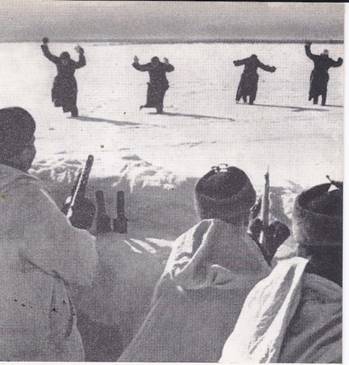
The bombing of Sicily began in May and in June the island of Pantelleria surrendered. On July 10, the first of 150,000 American, British and Canadian troops landed in Sicily itself. The Germans there fought back, but the Italian soldiers, who had had enough of war, surrendered in great numbers. Rome was bombed and the Italian people began to turn against Mussolini. On July 25 he was forced to resign and Italians poured into the streets, cheering the end of Italian Fascism.
Churchill and Roosevelt had met again in May, in Washington and had decided to invade Italy. Now, after the conquest of Sicily and the fall of Mussolini, they waited to see what Marshal Pietro Badoglio, the new head of the Italian government, would do. When he hesitated to sign an armistice, Italy was again bombed and on September 3, 1943, Badoglio agreed to armistice terms. That same day, British forces landed in Italy and five days later British and American troops made an amphibious landing at Salerno.
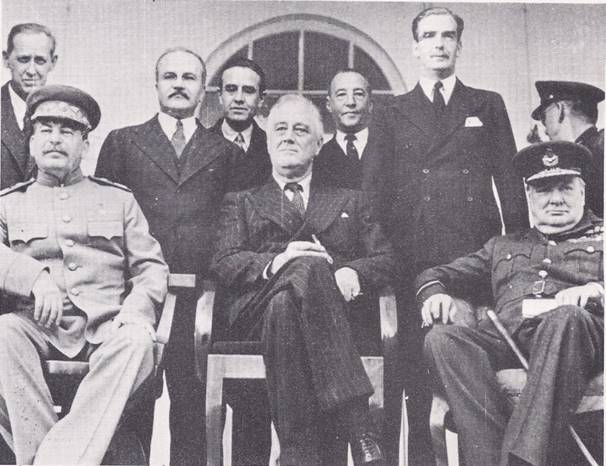
Although the Italians were out of the fighting, the Germans rushed in fresh troops and the American and British forces faced months of bloody fighting. In October they captured Naples, and Italy’s new government declared war on Germany. The Allied attack was stalled until May of 1944, when, after bitter fighting at Anzio, Cassino fell. As the Americans and British pushed their way forward, the Germans withdrew from Rome. Allied troops entered the city on June 4, 1944, to be greeted by cheering crowds and Rome became the first European capital to be recaptured from the Nazis. Even so, there would be another year of hard fighting before all of Italy was in the hands of the Allies. Mussolini, who had been arrested, was rescued by the Germans and brought to North Italy. There, guided and guarded by the Nazis, he set up another Fascist government, but it won little support from the Italians.
At the same time, the Germans were meeting defeat after defeat in Russia. The soldiers of the Red Army won back the cities of Kursk, Orel and Kharkov, pushed the Germans away from Leningrad and took Kiev. They forced the Germans out of Sevastopol and the Crimea and out of the city of Odessa. By the early months of 1944, the Russians had crossed into Poland and reached the border of Czechoslovakia. Everywhere the Germans were retreating, giving up thousands of square miles of territory. Instead of growing weaker, as the Germans had expected, the Russians were growing stronger. They put more and more planes into the air, repaired their railroads, brought up fresh troops — and drove on. All along, American industry was turning out an enormous amount of war materials, supplies and American and British bombers were hammering at German cities.
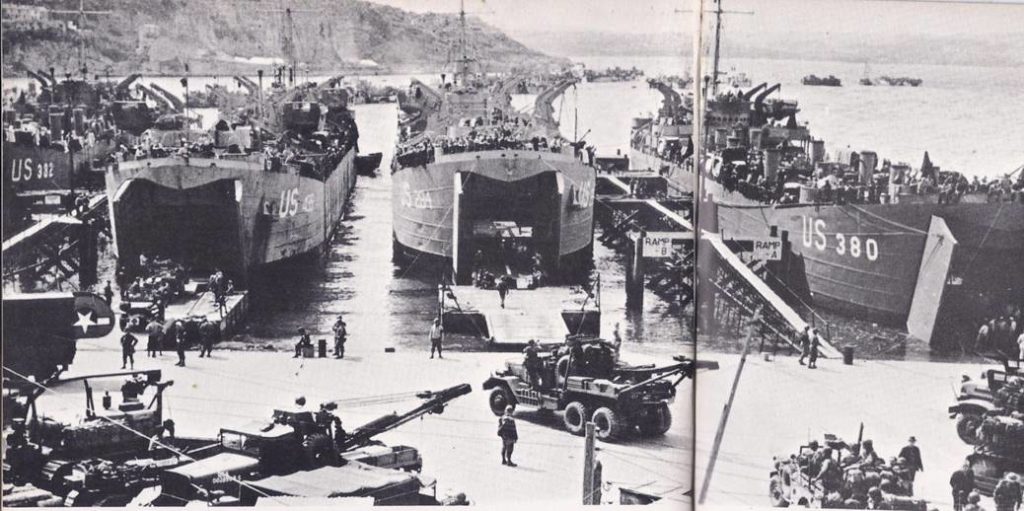
Meeting at Teheran late in 1943, Roosevelt, Churchill, and Stalin had agreed to open a second front in France. They kept their plans secret, but they made no secret of their intention to bring about the defeat of Germany. They said, “No power on earth can prevent our destroying the German armies by land, their U-boats by sea and their war plants from the air. Our attacks will be relentless and increasing.”
On June 6, 1944, the day after the fall of Rome, the allies were ready for what they called D-Day, the day of invasion. Vast preparations had been going on for months. Men and materials, including 10,000 planes, had been assembled in the British Isles for a campaign that would drive into France and toward Germany. The Allied Expeditionary Forces, under the command of General Eisenhower, were made up of troops from the United States, Britain, Canada and other countries. Four thousand ships carried the men, thousands of vehicles and thousands of tons of supplies to the beaches of Normandy. A thousand planes carried airborne troops or towed gliders; a thousand other planes carried bombs. Altogether, it was the “greatest and most successful combined operation of its type in military history.”
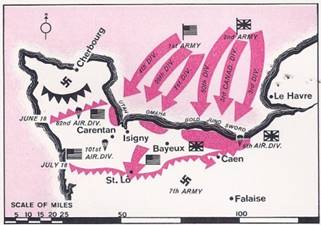
Under cover of a bombardment from eighty warships and bombing from planes‚ the first force landed between St. Marcouf and the Orne River. Taken by surprise, the Nazis lacked the planes to beat off the attack. Although there was hard fighting, particularly on “Omaha” beach, the allied forces were able to establish a beachhead sixty miles long. Within twenty-four hours they had landed about 250,000 troops‚ and by July 2 they took the port of Cherbourg. In the first hundred days after D-Day, they landed 2,200‚000 men, 450,000 vehicles and 4,000‚000 tons of supplies.
For a while the Germans slowed the allied advantage; then American armoured troops broke the German lines at St. Lo. Now the allied forces surged forward, in the north of France as well as in the east and the Germans were on the run. Members of the Free French underground were also striking at the Germans and on August 19 they rose up against the Nazi soldiers in Paris. Again barricades were built in the streets of the old city. After four days of fighting the German commander agreed to an armistice, but the next day he ordered his men to go on fighting. The French received some help from the allied forces and on August 25 Parisians crowded the streets to celebrate their return to freedom.
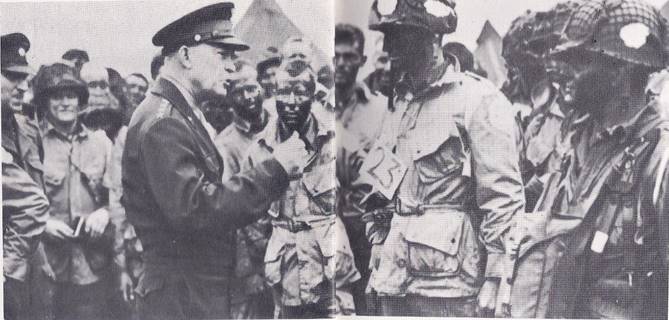
By this time the allies had overcome the submarine menace and supplies were flowing to all the armies. They had also won control of the air and dropped thousands of tons of bombs on Germany. The Germans tried to hit back by launching “buzz bombs” — rockets controlled by radio — against Britain. Although the buzz bombs killed more than 3,000 persons, most of them civilians, they had little effect on the war.
More important was Germany’s attack in the Ardennes region, which began on December 16, 1944, Supported by tanks and jet plans, a force of 250,000 Germans smashed through the American lines. They advanced fifty miles, until they were within three miles of the Meuse River and their lines formed a huge bulge. The German offensive war a desperate gamble. If it succeeded, the Germans would break through and advance to the sea, thus cutting the allied army in half. After that, they might drive the allies out of France altogether. But if the offensive failed, nothing could prevent the allies from marching into Germany.
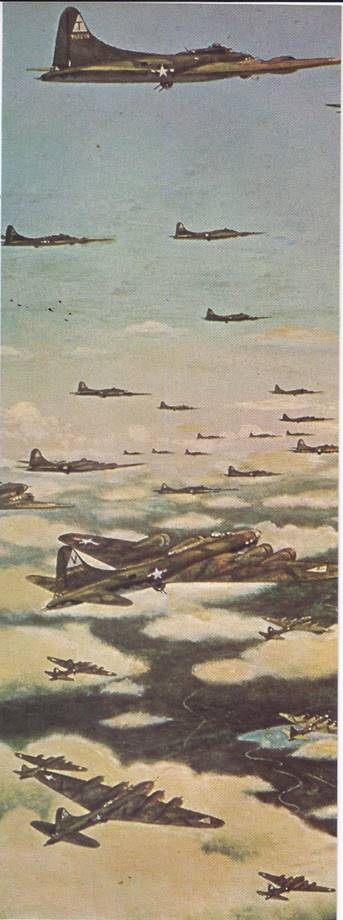
It might have succeeded had it not been for the town of Bastogne. To advance farther, the Germans had to capture Bastogne, But the American garrison in Bastogne held out day after day, giving the American army time to rush reinforcements to the front. On December 26, the Germans retreated from Bastogne. They had lost the gamble; within a month they were pushed back. The allied armies had won the “Battle of the Bulge” and were ready for the final assault on Germany.
The Russians had continued to push back the Germans. As the Red Army swept beyond the border of Russia, Hitler’s allies began surrendering and turning against him. In September of 1944 it was Finland and Rumania; in October it was Bulgaria. The Germans had to give up Greece and of their allies, only Hungary still fought against Russia. In January of 1945, while the Battle of the Bulge was being fought, the Russians prepared for a great attack. Driving through Hungary, Poland and East Prussia, they pushed on toward Berlin. Meanwhile, the American and other allied forces were relentlessly advancing, smashing the German defenses. On March 8, the United States First Army crossed the Rhine River at Remagen — the first time since Napoleon that an invading army had reached the Rhine. The following month, the United States Ninth Army reached the Elbe River, the Russians began to fight their way into Berlin and advance units of the American and Russian forces shook hands as they met on the bridge over the Elbe River at Torgau. Germany had lost her most important industrial regions; the Nazis could not hold out much longer.
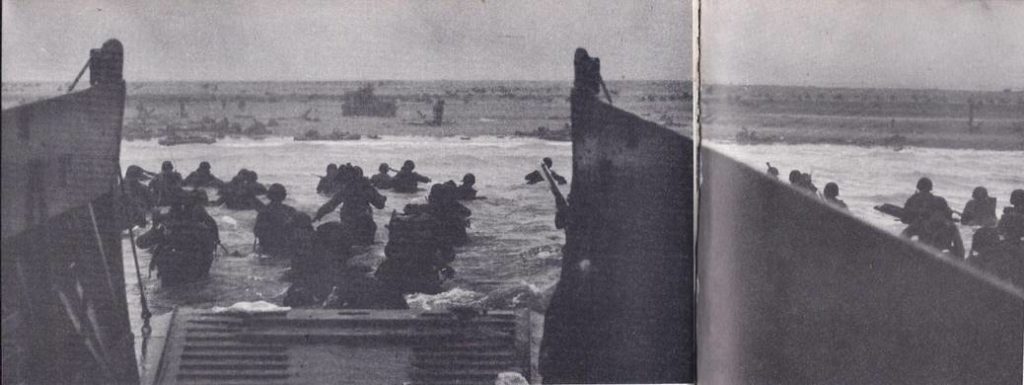
In Italy, as the American and British armies advanced, Italian “partisans”– anti-Fascist fighters –also attacked the Germans. City after city fell to the allies and the partisans and on April 29 the German and Italian armies in northern Italy and southwestern Austria surrendered.
The Germans no longer had any use for Mussolini and left him to look after himself. Captured by partisans on April 28, he pleaded, “Let me save my life and I Will give you an empire!” The partisans paid no attention to his offer and the next day they shot him. His corpse was taken to Milan, strung up by the heels from a lamp post in the public square and then dumped into the gutter. A crowd of thousands of persons gathered around the lifeless body of the dictator who had wanted to be another Caesar, kicking him, spitting at him, shouting, “He died too quickly! He should have suffered!” One woman fired a pistol at him, crying, “Five shots for my murdered sons!”
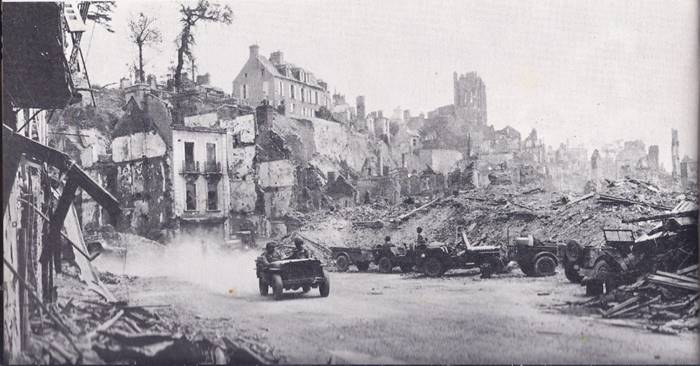
The news of Mussolini’s death reached his fellow-dictator, Hitler, in Berlin. Hitler had taken shelter in his bunker in the cellars of the Chancellory Building. He could feel the building shake from the crash of artillery fired by the Russians as they surged forward through the streets. Hitler had boasted that his empire would last a thousand years; now, like the city itself, it was in ruins. He had told the Germans that they were a master-race; now, the master-race was fleeing from men who had been marked as their slaves. He had risen to power on lies and bluff; now he was in a corner he could not lie or bluff his way out of. He had unleashed the might of his troops against defenseless people; now his troops were falling before a superior might. He had sent millions of people to their deaths; now he faced the finality of death himself.
Two of Hitler’s most trusted associates, Hermann Goering and Heinrich Himmler, had fled, but Goebbels remained with him. On April 30, after one last lie — he blamed Germany’s defeat on the “disloyalty and betrayal” of others — Hitler shot himself. In keeping with his orders, his body was taken into the garden, drenched with gasoline and burned. On May 1, Goebbels poisoned his six children, then had himself and his wife shot by an orderly. The two bodies were also set afire and burned in the garden.
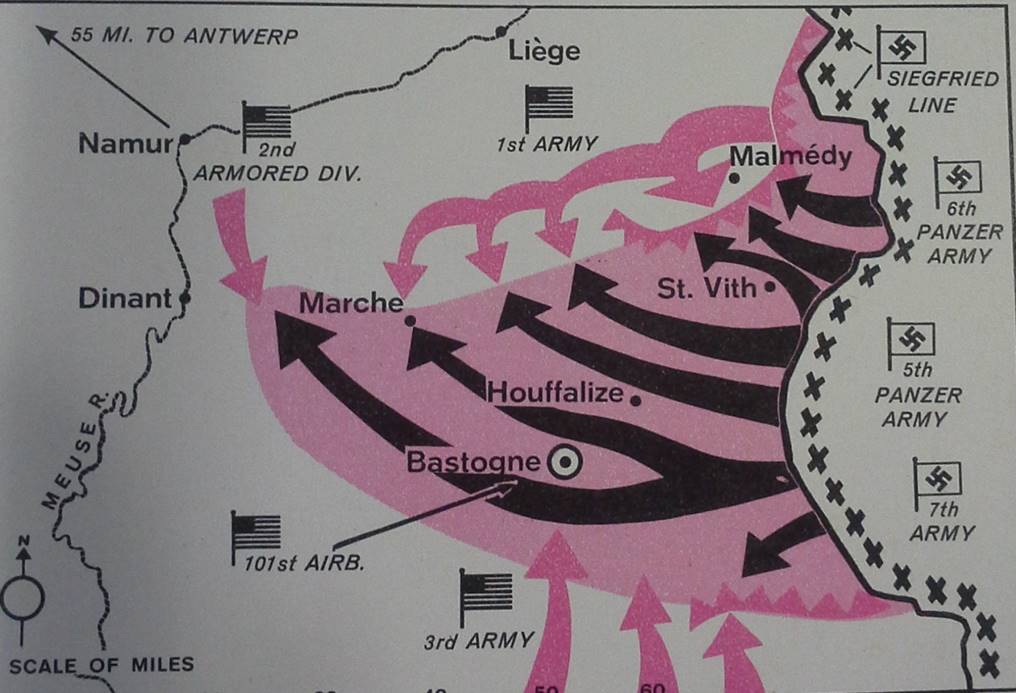
On May 7, 1945, Germany surrendered and at one minute after midnight, on May 9, all fighting stopped. The guns were silent at last — and silent, too, were the millions of men, women and children the Nazis had murdered.
The war in Europe was over, but the war in the Pacific still went on.
